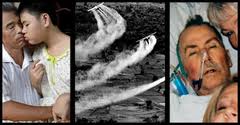Alex Constantine - February 27, 2011
" ... Hydro's own records ... boast that in one 12-year period, the power company dropped enough chemicals in Ontario to cover a 30-metre-wide swath travelling 'four-fifths the distance around the world.' ... The Toronto Star interviewed former Hydro employees ... who were assured the chemicals were harmless. The illnesses they've been dealing with the past few decades tell a different story. ... ”
Toronto Star | February 27, 2011
 Ontario Hydro used Agent Orange to clear power line corridors across the province, through city backyards and thick rural brush.
Ontario Hydro used Agent Orange to clear power line corridors across the province, through city backyards and thick rural brush.
Hydro's own records, obtained by the Star, boast that in one 12-year period, the power company dropped enough chemicals in Ontario to cover a 30-metre-wide swath travelling “four-fifths the distance around the world.”
The Ontario Hydro revelation moves health concerns over the toxin closer to highly populated areas of the province, with spraying on hundreds of thousands of kilometres of hydro corridors looping through parks and farmers' fields.
For months at a time, summer students and salaried Hydro labourers would fan out across Ontario with metal knapsacks filled with poisonous chemicals strapped to their backs. The company also loaded hundreds of gallons of herbicides onto all-terrain vehicles, helicopters, army trucks, swamp tractors and even horses to help workers access every nook and cranny, according to the Star's ongoing investigation.
“Every power line in Ontario was sprayed,” said Sidney Rodger, a former Hydro supervisor who worked in eastern Ontario from 1958 to 1968.
“All this spraying was done in urban and rural areas with no regard for creeks and streams or residents and wildlife.”
The Toronto Star interviewed former Hydro employees, including summer students and senior managers, who were assured the chemicals were harmless. The illnesses they've been dealing with the past few decades tell a different story.
The men came forward after a Star investigation published last week revealed that the most widely used chemical in the Vietnam War was also employed at large by Ontario's Department of Lands and Forests to strip massive plots of Crown land during the 1950s, '60s and '70s.
A Hydro One spokeswoman confirmed the utility also used Agent Orange across Ontario from 1950 to 1979.
Daniele Gauvin said anyone with concerns can contact Hydro One, a company created in 1998 to replace Ontario Hydro. Gauvin said people are welcome to call the “corporate switchboard.” Meanwhile, government officials are probing the effects of Agent Orange use by provincial ministries in northern Ontario and along roadsides across the province.
“Spraying can be a bitter pill to the public,” states an Ontario Hydro training document from 1962. It advised spraying supervisors “to practise courtesy, care and common sense.”
To convince farmers to allow Hydro spray crews onto their pastures, some supervisors would dip a cup into the chemical tank and take a swig.
“We were just young, single guys making big money,” said Orval Newton, 64, who earned $2.06 an hour as a labourer power-spraying trees and brush beneath high-voltage lines from Parry Sound to Toronto in 1967.
Bread cost 25 cents a loaf at the time and regular gasoline was 41.9 cents a gallon.
“We had no protection,” he said. “The drift would come back into your face. You'd finish the day with your clothes soaked.”
Four years ago, Newton was diagnosed with Parkinson's disease, one of more than 50 medical conditions the U.S. Department of Veterans Affairs associates with exposure to Agent Orange.
George Hambley, 62, spent three summers spraying near Kirkland Lake during the early 1970s. A massive tractor carrying hundreds of gallons of chemicals rolled through the brush. Attached to the chemical tank were three high-pressure hoses usually carried by seasonal workers like him.
“The guy on the middle hose got it bad,” he said. “Sometimes we'd start to gag because the spray was so thick.
A few years after he finished with Hydro, still in his 20s, Hambley started to lose feeling in his toes. Year by year, the numbness spread to his legs and hands. His official diagnosis is neuropathy, a disorder the U.S. Department of Veterans Affairs also associates with exposure to Agent Orange.
When Hambley was in his 30s, thick, red patches of skin with flaky, silver-white scales started to appear; they now cover 75 per cent of his body.
“On hot days, and with the blessing of our foreman, we would spray each other with this ‘safe' concoction,” recalls Bryan Ostrowski, 69, who worked with the chemicals as a teenager in northern Ontario.
“We would spray upwards beneath the trees,” he said. “We did this day in and day out.” He was 15 his first year.
Ostrowski started developing heart problems in his 20s. He had his first bypass at 41 and now has a stent. Polyps riddled his nasal cavities. The polyps were removed in his 30s.
Richard Monk, 58, recalls members of his spray gang in Parry Sound complaining about the noxious chemicals shortly after he started working for Ontario Hydro in 1975. His crew used “many, many chemicals,” including an equal-parts cocktail of the herbicides 2,4-D and 2,4,5-T mixed in diesel fuel — Agent Orange.
“There were times we couldn't open our eyes in the morning,” he said, because the toxins seemed to glue them shut. “We had to walk down the cabin feeling the walls to find a basin to bathe them.”
The company responded to these complaints, he said, by conducting a study of workers' urine and monitoring the air with some kind of breathing apparatus.
Monk, who retired from the company as a superintendent for northern Ontario after 34 years of service, said he supplied urine samples for two weeks.
“We never got the results.”
In 2000, at the age of 48, Monk was diagnosed with bladder cancer. Hydro One could not provide the Star with the results of the urine study. A spokesperson said Ontario Hydro's records are archived with Ontario Power Generation.
Hydro One pointed the Star to a different study, based on a questionnaire, that concluded forestry workers who were routinely exposed to poisonous herbicides were no more likely to die of cancer than men in the general population, though it did show a significant increase in suicide.
The study tracked 1,222 Hydro employees who worked for six months or more between 1950 and 1982 and who were routinely exposed to herbicides. The report is based on two questionnaires workers were asked to fill out.
The Star asked a leading U.S. epidemiologist who has studied the effects of Agent Orange on military veterans to review the report.
“No one should derive comfort or reassurance of safety” from the Ontario study, said Dr. Joel Michalek, the lead scientist in a prominent U.S. study that tracked the health of about 1,000 military veterans who participated in Operation Ranch Hand — a series of Air Force missions that sprayed defoliants over 1.4 million hectares of South Vietnam.
“Among epidemiology studies, this particular study offers the weakest form of evidence, with no control group and no measurement of the dioxin contaminant in people who comprised the cohort,” said Michalek from San Antonio, where he is vice-chair of the epidemiology department at the University of Texas Health Science Center.
David McCarty spent two summers in the early 1960s spraying power lines for Ontario Hydro near his hometown of New Liskeard, Ont. He was 17 years old his first year.
“I needed a goddamn job,” he said. “In those days, my dad was a guard at the jail. He made $5 an hour. I was making $11 an hour in the bush. Sometimes, I think it was shut-up money.”
He's 64 years old. He's had two heart attacks, the first at age 37. He's been treated for mouth and skin cancer. Doctors twice extracted melanomas from his nose.
He was not part of the Ontario study, he said.
“I've been talking with a girl from the WSIB (Workplace Safety and Insurance Board). She wanted me to put in a claim,” he said. “My doctor says nobody is going to tell you this is connected.”
McCarty sprayed power lines from Abitibi Canyon to Sudbury.
“When we'd come back the next day, you could tell where we left off because the leaves would be brown and curling,” he said.
After a day spent in the thick chemical fog, the workers rarely bathed.
“If you cleaned up at night, you'd get eaten alive by blackflies,” he said. “You would wash the palm of your hands and your mouth and that's it! We stunk like hell.”
Tom Plaunt was 19 during his first summer of spraying. For him, it was a sort of initiation into manhood.
“That's where I learned to smoke cigarettes, drink beer and swear like a trooper,” said Plaunt, 66, a retired university music professor in Montreal.
He worked on Hydro's spray crews west of Shining Tree, Ont., for two summers in the 1960s.
Still, he can't help but wonder if the wart-like growths that began covering his body shortly after his work with Ontario Hydro are connected to the chemicals he sprayed.
The chemical mixture would stick to his skin “for days,” he said.
“The men working with this stuff would lose a layer of skin a week,” said Rodger, 75, who left Hydro to become a teacher.
Many of the men he worked with developed white blotches on their hands and faces. As for his own health, Rodger said he's feeling fine. His youngest son, though, was born with an extra finger, which doctors removed at birth.
Is there a connection? Hard to say.
Rodger is certain of one thing.
“I'm not looking for remuneration,” he said. “I just want the truth to come out.”
Diana Zlomislic can be reached at dzlomislic@thestar.ca or (416) 869-4472






